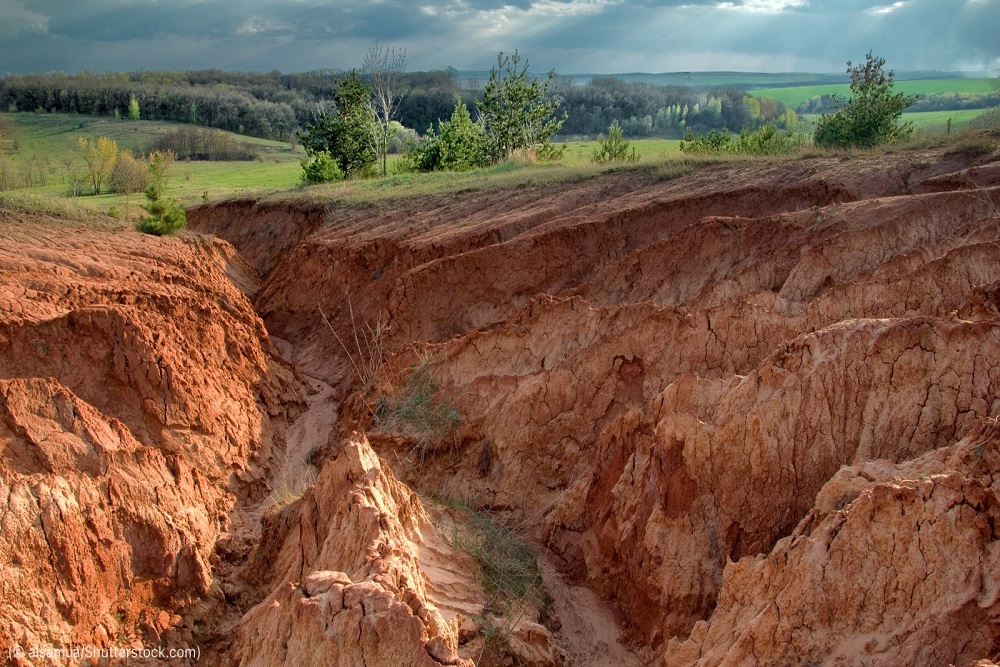The Science Speaks blog series offers a deep dive into science, technology, and innovation topics on the minds of the public. The series explains focal topics through relatable analogies and asks readers to consider key opportunities, explore avenues for advancing gender equity and equality, and answer the ultimate question: Why should we care?
In 2009, the futuristic film Avatar took cinemas by storm to tell the fictional story of human interactions with the Na’vi, a humanoid species living on a forest-covered moon called Pandora. I was recently reminiscing about this story (having stumbled across the teaser trailer for its sequel) and was startled to realize that many of the movie’s themes remain relevant today—13 years after its theatrical release.
One of those themes is a cautionary tale about the dangers of land degradation, the deterioration of land caused directly or indirectly by human activities. In Avatar, humans only encounter the Na’vi because Earth’s land and natural resources have been degraded. In the real world, land degradation is truly a global challenge, affecting at least 25% of land and as many as 3 billion people worldwide, with disproportionate impacts felt by women and girls.
Land degradation is closely linked to reduced quality and stability of soil, initiating a chain reaction that affects all elements of an ecosystem. The erosion of soil by water, wind, and land-disturbing processes (including use of certain farming equipment) is a form of physical degradation. Chemical degradation includes increasing acidity, salinity, or contamination through various sources of pollution.
Tilling and other unsustainable agricultural practices hasten land degradation.
The root causes (pun intended) of land degradation are vast. Some of the most significant contributors include unsustainable agricultural practices, such as tillage and livestock overgrazing, which can deplete soil nutrients or vegetation cover and expose soil to erosion. Deforestation and clearcutting also contribute substantially; loss of root systems decreases soil stability, while removal of native plants harms biodiversity and allows invasive species to proliferate. These impacts may be felt in Avatar when humans seek to destroy Pandora’s Hometree and Tree of Souls.
Avatar depicts some other activities that can lead to land degradation, as well. In the movie, humans seek to mine the fictitious mineral “unobtainium” on Pandora, a process that would disturb the land and create pollution. Indeed, industrial processes, mining, and quarrying can degrade land. Regardless of the cause, impoverished and rural communities, as well as smallholder farmers (descriptors that apply to hundreds of millions of women), are most impacted by land degradation.
The challenge is further complicated by the climate crisis, whose effects hasten land degradation in coastal, wetland, and especially dryland regions. For example, more frequent and intense droughts accelerate the desertification of once-arable lands, while sea level rise and flooding increase soil salinity or contaminate irrigation supplies, particularly in coastal and island communities.
But land degradation also contributes to climate change, releasing massive quantities of carbon (stored in soil) into the atmosphere. It also decreases land productivity, biodiversity, and ecosystem services, which, in turn, heightens risk of economic loss (in agriculture, ecotourism, and other sectors), poverty, food insecurity, susceptibility to extreme weather events, and even conflict (as depicted in Avatar). All these impacts present unique or disproportionate difficulties for women and girls.
Consider that, in developing countries, almost 80% of employed women work in agriculture, where they must try to salvage the productivity of quickly degrading land. Plus, women and girls often collect forest products, such as firewood and medicinal plants, which may grow scarce over time. Depletion of natural resources is correlated with increased responsibility for domestic work, risk of gender-based violence, and likelihood of food insecurity. Even so, women and girls are leaders in adopting conservation practices.
Agroforestry, which integrates trees and shrubs into farming systems for crops and livestock, is one example of a practice that improves agricultural sustainability.
The myriad manifestations of land degradation—ranging from desertification in Asia, the Middle East, and North Africa to soil erosion in the U.S. Great Plains—necessitate a suite of solutions. Adoption of sustainable agriculture and land management practices and preventing deforestation (the Na’vi did save the Tree of Souls) are two tools in the toolbox. Another is ensuring that women have land rights and access to resources needed to make more sustainable land use decisions.
The U.S. Government is committed to addressing the environmental and social impacts of climate challenges, including those related to land degradation. The State Department works with allies and partners to prevent desertification, engage in reforestation, and tackle soil erosion. This includes investment in organizations that deploy technologies to protect natural resources, as well as foreign assistance programming that promotes women’s land rights. Various projects are facilitating regional forest management, bolstering land productivity, supporting sustainable land use, measuring carbon storage, and more.
Avatar may be more than a decade old, but plenty of opportunities still exist to address the earthly challenges it depicts. How could your actions help counter land degradation?
Original source can be found here.









